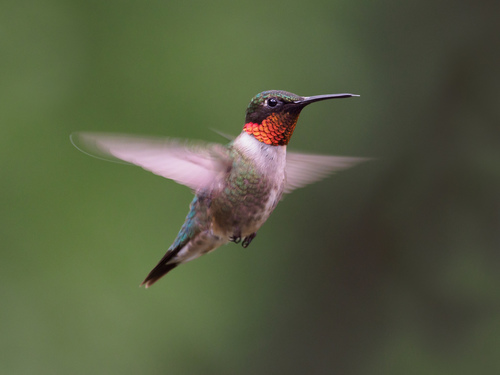
Ruby-throated Hummingbird
The Ruby-throated Hummingbird (*Archilochus colubris*) is a small, vibrant bird known for its remarkable flying abilities and jewel-like appearance. It plays a crucial role as a pollinator for various flowering plants across its range. This species is the only breeding hummingbird regularly found east of the Mississippi River in North America, making it a familiar and beloved sight in gardens and woodlands. While not currently considered globally threatened, its dependence on specific habitats and nectar sources makes it vulnerable to environmental changes.
7-9 cm
Length
8-11 cm
Wingspan
Least Concern
Conservation Status
Distribution
Breeds across eastern and central North America, from southern Canada to the Gulf Coast. Winters primarily in Central America, from Mexico to Panama, and occasionally in the Caribbean.
Lifespan
Average lifespan in the wild is 3-5 years, with a maximum recorded lifespan of 9 years.
Ruby-throated Hummingbird's Habitat
Habitat Types
Deciduous and mixed forests, Woodlands, Orchards, Gardens, Parks
Climate Zones
Temperate, Subtropical, Tropical (during winter)
Adaptations
Their long, slender bills and specialized tongues are adapted for extracting nectar from tubular flowers. Their high metabolic rate requires frequent feeding, and they can enter a state of torpor (a short-term hibernation-like state) to conserve energy during cool nights.
Variations
No recognized subspecies.
Appearance
Breeding Plumage
Males have a brilliant iridescent ruby-red throat (gorget) during breeding season, which can appear black in poor light. Females lack the red gorget and have a whitish throat.
Seasonal Feather Changes
Little seasonal variation beyond the intensity of the male's gorget.
Sex Based Plumage Differences
Significant sexual dimorphism; males have the red gorget, while females have a white throat and are generally duller green.
Notable Features
Iridescent green back, Long, needle-like bill, Rapid wingbeats (up to 53 beats per second)
Diet and Feeding
Primary Foods
Nectar from flowers, Small insects, Spiders, Tree sap (occasionally)
Foraging Behavior
Hovers in front of flowers while feeding, using its long bill and tongue to extract nectar. Also gleans insects from leaves and catches them in mid-air.
Specializations
Brush-tipped tongue with grooves to efficiently collect nectar. High metabolic rate requires frequent feeding.
Seasonal Diet Variations
Diet shifts slightly depending on the availability of nectar and insects. Insects become more important during breeding season to provide protein for growing chicks.
Behavior
Social Structure
Generally solitary, except during breeding season. Males are highly territorial and will defend feeding areas.
Communication
High-pitched chirps and chatters, Wing hums (produced by rapid wingbeats), Visual displays (e.g., dive displays, gorget flashing)
Migration
Migrates long distances, with some individuals flying non-stop across the Gulf of Mexico (over 500 miles). Migration is triggered by changes in day length and food availability.
Territorial or Group Behaviors
Males aggressively defend feeding territories, especially during breeding season. Females may also defend nesting territories.
Conservation
Threats
Habitat loss (both breeding and wintering grounds), Pesticide use (affecting insect prey and potentially nectar sources), Climate change (altering flowering times and migration patterns), Collisions with windows
Protection Programs
Habitat restoration projects, Promotion of native plant gardens, Public awareness campaigns about window collisions
Local National Laws
Protected under the Migratory Bird Treaty Act in the United States and similar legislation in Canada and Mexico.
Population Trend
Stable
Population Estimates
Estimated global population of 34 million.
Interesting Facts
They can fly backward.
Hummingbirds are the only birds that can fly backward, a maneuver used for navigating around flowers and escaping threats.
Their heart rate can reach over 1,200 beats per minute during flight.
This incredibly high heart rate is necessary to support their high metabolic rate and rapid wingbeats.
They can remember individual flowers and feeding locations.
This spatial memory helps them efficiently find food sources.
They consume about half its body weight in sugar daily.
This substantial intake provides fuel for its high metabolism and energy-intensive flight.
Faqs about Ruby-throated Hummingbird
What can I do to attract Ruby-throated Hummingbirds to my yard?
Plant native flowering plants, especially those with red or orange tubular flowers. Provide a hummingbird feeder with a sugar-water solution (1 part white sugar to 4 parts water, no red dye). Avoid using pesticides.
How can I tell a male from a female Ruby-throated Hummingbird?
Only adult males have the ruby-red throat (gorget). Females and immature males have a white throat.
Do hummingbird feeders prevent them from migrating?
No, providing feeders does not prevent hummingbirds from migrating. They are triggered to migrate by changes in day length, not food availability.
Where do they go in winter
Ruby-throated Hummingbirds migrate south, primarily to Central America, stretching from Mexico to Panama. A small number also spend the winter in the Caribbean.
Copyright @ Nature Style Limited. All Rights Reserved.
 English
English